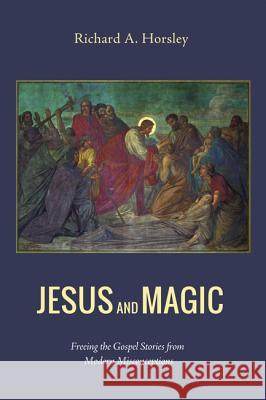Jesus and Magic » książka
Jesus and Magic
ISBN-13: 9781498201728 / Angielski / Miękka / 2014 / 194 str.
Jesus and Magic
ISBN-13: 9781498201728 / Angielski / Miękka / 2014 / 194 str.
(netto: 94,38 VAT: 5%)
Najniższa cena z 30 dni: 98,55
ok. 16-18 dni roboczych.
Darmowa dostawa!
It has become standard in modern interpretation to say that Jesus performed miracles, and even mainline scholarly interpreters classify Jesus's healings and exorcisms as miracles. Some highly regarded scholars have argued, more provocatively, that the healings and exorcisms were magic, and that Jesus was a magician. As Richard Horsley points out, if we make a critical comparison between modern interpretation of Jesus's healing and exorcism, on the one hand, and the Gospel stories and other ancient texts, on the other hand, it becomes clear that the miracle and magic are modern concepts, products of Enlightenment thinking. Jesus and Magic asserts that Gospel stories do not have the concepts of miracle and magic. What scholars constructed as magic turns out to have been ritual practices such as songs (incantations), medicines (potions), and appeals to higher powers for protection. Horsley offers a critical reading of the healing and exorcism episodes in the Gospel stories. This reading reveals a dynamic relationship between Jesus the healer, the trust of those coming for healing, and their support networks in local communities. Horsley's reading of the Gospel stories gives little or no indication of divine intervention. Rather, the healing and exorcism stories portray healings and exorcisms. ""A brilliant rethinking and reframing of evidence that powerfully challenges some long-held assumptions in NT scholarship. Not all scholars will agree with every point but Horsley persuasively shows that the modern use of 'miracle' and 'magic' reflect the postbiblical history of those terms, and this work certainly lays to rest the thesis of 'Jesus the magician.'"" --Craig S. Keener, Asbury Theological Seminary ""Jesus was no 'miracle-worker' or 'magician' but a healer who encountered scores of the ill and the spirit-possessed, welcomed their trust in his power to heal, and mediating God's healing power, reintegrated them into society. His healings and exorcisms were perceived by his followers as manifestations of the direct rule of God in human community and key means for the renewal of Israel in opposition to the Jerusalem establishment. A must read for Bible translators and interpreters, as well as an eye-opener for students, preachers, and general readers."" --John H. Elliott, University of San Francisco ""Horsley challenges the traditional understanding of Jesus's activity as miracles and/or magic. Instead, he argues convincingly for a relational and contextual approach to analyzing the figures and scenes in the gospel healing and exorcism stories about Jesus. They make sense only in the concrete sociocultural context of Roman Palestine and Israelite tradition. This is Horsley at his critical best."" --John J. Pilch, Johns Hopkins University Richard Horsley, Professor Emeritus at University of Massachusetts Boston, is author of numerous books on Paul, on the Gospels, and on the historical Jesus, including Jesus and Empire (2003) Jesus and the Powers (2011) and, more recently, Text and Tradition in Performance and Writing (Cascade Books, 2013).
It has become standard in modern interpretation to say that Jesus performed miracles, and even mainline scholarly interpreters classify Jesuss healings and exorcisms as miracles. Some highly regarded scholars have argued, more provocatively, that the healings and exorcisms were magic, and that Jesus was a magician. As Richard Horsley points out, if we make a critical comparison between modern interpretation of Jesuss healing and exorcism, on the one hand, and the Gospel stories and other ancient texts, on the other hand, it becomes clear that the miracle and magic are modern concepts, products of Enlightenment thinking. Jesus and Magic asserts that Gospel stories do not have the concepts of miracle and magic. What scholars constructed as magic turns out to have been ritual practices such as songs (incantations), medicines (potions), and appeals to higher powers for protection.Horsley offers a critical reading of the healing and exorcism episodes in the Gospel stories. This reading reveals a dynamic relationship between Jesus the healer, the trust of those coming for healing, and their support networks in local communities. Horsleys reading of the Gospel stories gives little or no indication of divine intervention. Rather, the healing and exorcism stories portray healings and exorcisms.""A brilliant rethinking and reframing of evidence that powerfully challenges some long-held assumptions in NT scholarship. Not all scholars will agree with every point but Horsley persuasively shows that the modern use of miracle and magic reflect the postbiblical history of those terms, and this work certainly lays to rest the thesis of Jesus the magician.""--Craig S. Keener, Asbury Theological Seminary""Jesus was no miracle-worker or magician but a healer who encountered scores of the ill and the spirit-possessed, welcomed their trust in his power to heal, and mediating Gods healing power, reintegrated them into society. His healings and exorcisms were perceived by his followers as manifestations of the direct rule of God in human community and key means for the renewal of Israel in opposition to the Jerusalem establishment. A must read for Bible translators and interpreters, as well as an eye-opener for students, preachers, and general readers.""--John H. Elliott, University of San Francisco""Horsley challenges the traditional understanding of Jesuss activity as miracles and/or magic. Instead, he argues convincingly for a relational and contextual approach to analyzing the figures and scenes in the gospel healing and exorcism stories about Jesus. They make sense only in the concrete sociocultural context of Roman Palestine and Israelite tradition. This is Horsley at his critical best.""--John J. Pilch, Johns Hopkins UniversityRichard Horsley, Professor Emeritus at University of Massachusetts Boston, is author of numerous books on Paul, on the Gospels, and on the historical Jesus, including Jesus and Empire (2003) Jesus and the Powers (2011) and, more recently, Text and Tradition in Performance and Writing (Cascade Books, 2013).











